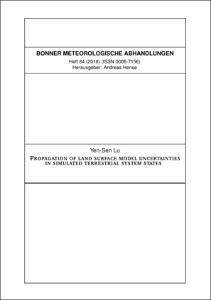Propagation of land surface model uncertainties in simulated terrestrial system states

Propagation of land surface model uncertainties in simulated terrestrial system states

| dc.contributor.advisor | Simmer, Clemens | |
| dc.contributor.author | Lu, Yen-Sen | |
| dc.date.accessioned | 2020-04-25T02:40:16Z | |
| dc.date.available | 2020-04-25T02:40:16Z | |
| dc.date.issued | 15.05.2018 | |
| dc.identifier.uri | https://hdl.handle.net/20.500.11811/7563 | |
| dc.description.abstract | This study demonstrates how vegetation uncertainty propagates in the terrestrial system and how to reduce this uncertainty. Different stomatal conductance equations and different leaf area index input exist for solving vegetation response to land-atmospheric interactions. We investigate the effect of vegetation uncertainty on land surface firstly, and then the extension of this uncertainty to subsurface is studied. We employ a land surface model, CLM3.5, and the coupled model, Parflow-CLM3.5, in the first and the second part of study, respectively. To quantify the uncertainty, we perform simulations with three stomatal conductance equations and the two leaf area index (LAI) input types. The three stomatal conductance equations include the Jarvis-Stewart type, the Ball-Berry-Collatz type, and the Ball-Berry-Leuning type, and the two LAI input types include the MODIS LAI and the simple dynamic LAI based on ground temperature. The simulations of CLM3.5 are driven with observed meteorological forcing data for the years 2012 and 2013, and are compared against observation at four vegetated sites in the Rur Catchment, which includes a grassland, two croplands, and a forest sites. The simulations of the coupled model Parflow-CLM3.5 are performed over the whole Rur Catchment with 2-D reanalysed weather forcing data. The results by CLM3.5 indicate that canopy conductance, which combines stomatal conductance and LAI, is the key of vegetation uncertainty propagation in the land surface model. The employment of updated physiological parameters can improve the simulations by the Ball-Berry type stomatal conductance equations. In the four sites, the simulations are well performed at the grass site, but are interrupted by crop management and canopy structure at the crop sites and the forest site, respectively. Both stomatal conductance equations and LAI input types affect the calculation of land surface model significantly, but the stomatal conductance equations have more impact on the land surface model than LAI. The Jarvis-Stewart type performs the simulated latent heat flux better but not under all the weather conditions. However, none of the types performs simulated sensible heat flux the best. We regard the Jarvis-Stewart type and the Ball-Berry type as two types of approach, which can both approach the real world well. Instead of judging which is the best equation, we shall investigate how to approach the real world by improving the parameterization and the physiological mechanism. From the results by Parflow-CLM3.5, we demonstrate that the soil water limitation factor, which combines soil moisture and root distribution, is the key propagating vegetation uncertainty to the subsurface and then to the surface. The Rur Catchment is determined by the soil water limitation factor as water-unlimited condition in the year 2012 and thus the heat flux does not change with the water table depth. In the year 2013, the Rur Catchment is in a water-limited condition, and thus the heat fluxes are affected by the water table depth. The simulations by the Jarvis-Stewart type show a stronger relation of heat fluxes with water table depth between soil water-unlimited and the soil water-limited condition. | en |
| dc.language.iso | eng | |
| dc.relation.ispartofseries | Bonner Meteorologische Abhandlungen ; 84 | |
| dc.rights | In Copyright | |
| dc.rights.uri | http://rightsstatements.org/vocab/InC/1.0/ | |
| dc.subject | Stomata | |
| dc.subject | Leaf area index | |
| dc.subject | Heat flux | |
| dc.subject | Groundwater | |
| dc.subject | Simulation | |
| dc.subject | Coupled model system | |
| dc.subject.ddc | 550 Geowissenschaften | |
| dc.title | Propagation of land surface model uncertainties in simulated terrestrial system states | |
| dc.type | Dissertation oder Habilitation | |
| dc.publisher.name | Universitäts- und Landesbibliothek Bonn | |
| dc.publisher.location | Bonn | |
| dc.rights.accessRights | openAccess | |
| dc.identifier.urn | https://nbn-resolving.org/urn:nbn:de:hbz:5n-50710 | |
| ulbbn.pubtype | Erstveröffentlichung | |
| ulbbnediss.affiliation.name | Rheinische Friedrich-Wilhelms-Universität Bonn | |
| ulbbnediss.affiliation.location | Bonn | |
| ulbbnediss.thesis.level | Dissertation | |
| ulbbnediss.dissID | 5071 | |
| ulbbnediss.date.accepted | 24.04.2018 | |
| ulbbnediss.institute | Mathematisch-Naturwissenschaftliche Fakultät : Fachgruppe Erdwissenschaften / Meteorologisches Institut | |
| ulbbnediss.fakultaet | Mathematisch-Naturwissenschaftliche Fakultät | |
| dc.contributor.coReferee | Langensiepen, Matthias |
Dateien zu dieser Ressource
Das Dokument erscheint in:
-
E-Dissertationen (4387)




